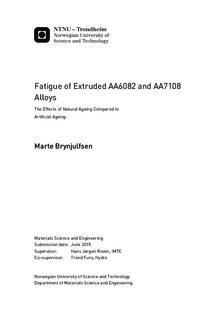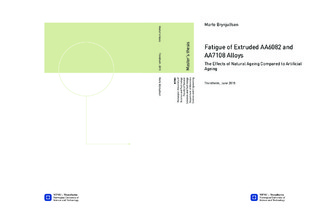| dc.description.abstract | Heat treatable aluminium alloys might have the potential to gain unexpected increase in mechanical properties when stored at room temperature (natural ageing) after extrusion, for long periods of time. The main aim of the present work is therefore to investigate the effects of long time natural ageing on fatigue life under constant amplitude loading in ambient air, i.e. for alloys AA6082 and AA7108.
The extruded AA6082 and AA7108 alloys have been investigated in four different temper states, T1, T4, T5 and T6. The T1 and T4 tempers represents naturally aged conditions at different storage times, i.e. more than 10 years and 3 weeks, respectively. The T5 and T6 tempers represents artificially aged conditions. The fatigue testing was performed as one-axial, high cycle fatigue, with the fatigue properties between 105 and 106 cycles to failure in focus. The relationship between fatigue strength and non-strength providing parameters such as the recrystallized layer, surface roughness, crystallographic texture and humidity have been accounted for. The different precipitated particles, providing strength, have also been considered, as they have a direct effect on the fatigue strength. To underline the fatigue properties, hardness change due to cyclic loading was measured and finally fractured surfaces were investigated.
The results show that stored aluminium alloys can gain ultimate tensile strengths comparable to heat treated conditions. Never the less, it is not always a direct relation between high tensile properties and good fatigue properties. Further, the results reveal that the naturally aged temper state (T4) and the stored temper state (T1) have the best fatigue properties. In addition, for both alloys, the peak aged condition, T6, has the poorest fatigue properties. | |

